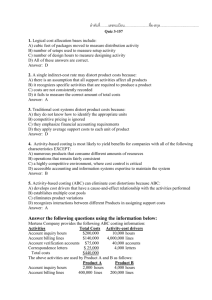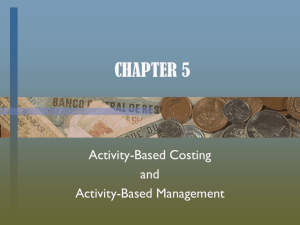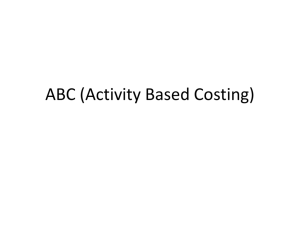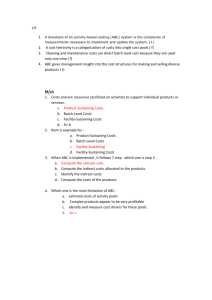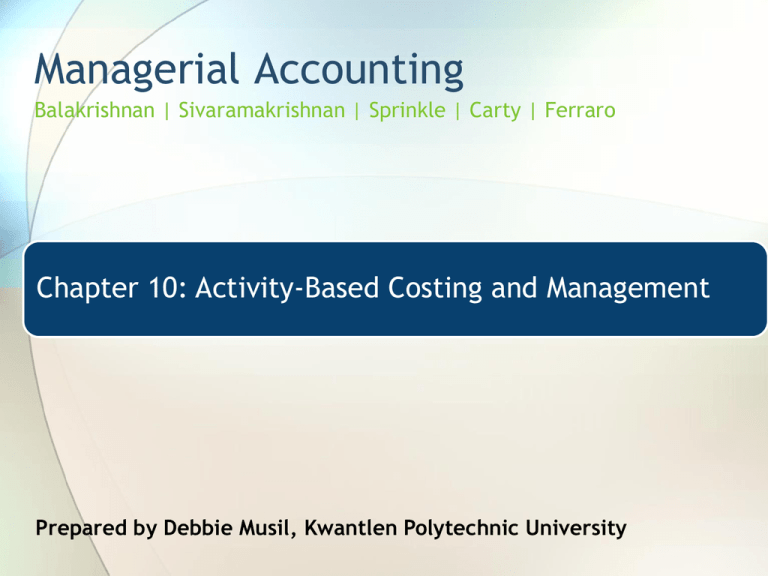
Managerial Accounting
Balakrishnan | Sivaramakrishnan | Sprinkle | Carty | Ferraro
Chapter 10: Activity-Based Costing and Management
Prepared by Debbie Musil, Kwantlen Polytechnic University
Overview
• Need good estimate of controllable costs to
improve quality of decisions
− Choices that we make when allocating costs
determine the validity of the estimated profit
margin
− Activity based costing is a method to refine our
allocation and improve validity of estimate
• Activity based management is the process of
taking ABC data to improve the effectiveness of
business processes
− Focused on Customer
− Focused on Production
− Focused on Product concepts and design
LO1: Understand the elements of an activity-based costing (ABC) system
Decisions When Allocating Costs
LO1: Understand the elements of an activity-based costing (ABC) system
$4,740,180
1 $0.95
2
$10
3 $9.50
1
$4,503,171 ÷ $4,740,180
2
$1,359,600 ÷ 135,960
3
$10.00 direct labor per linear foot × $0.95 / labour $
Step 1: Forming Cost pools
• Includes all costs
− Pre and post production
• Takes business process view
− A collection of activities
• Activities are the core building block of ABC
systems
− “Horizontal” view of organization
• Traditional costing takes “vertical” view
• Prepares activity map for each product
− Similarity to bill of materials and routing
sheet
LO1: Understand the elements of an activity-based costing (ABC) system
Activities at United Parcel Service
LO1: Understand the elements of an activity-based costing (ABC) system
Forming Cost Pools
• Activities can pertain to any level in the
activity hierarchy
− Activities done for each unit, each batch,
each product or for the facility as a whole
• The corresponding cost pools will correspond
to the cost hierarchy
− Unit, batch, product and facility level cost
pools
LO1: Understand the elements of an activity-based costing (ABC) system
Cost Pools at MKC
Cost
Pool
Number
Cost
Hierarchy
Underlying Activity
Name for
Cost Pool
1
Unit Level
Assembly of products
(includes intricate carpentry)
Labor related
2
Unit Level
Machining of product components
Machine
related
3
Batch Level
Issue and process production orders
(including production scheduling)
Production
order related
4
Batch Level
Receive and process customer orders
(including invoicing)
Customer
order related
5
Product
Level
Provide production support
(includes design updates)
Production
support
8
Facility
Level
General Administration
General
administration
LO1: Understand the elements of an activity-based costing (ABC) system
Step 2: Which Pools to Allocate?
Cost
Pool
Number
Name
Underlying Activity
Controllable?
1
Labour related
Assembly of products
Yes
2
Machine
related
Machining of product components
Yes
3
Production
order related
Issue and process production orders
(including production scheduling)
Yes
4
Customer
order related
Receive and process customer
orders (including invoicing)
Yes
5
Production
support
Provide production support
(includes design updates)
Yes (Mostly)
6
Marketing
support
Provide marketing support
(includes trade shows)
Yes (Mostly)
7
Warehousing
Warehouse products
Yes
8
General
administration
General Administration
No
LO1: Understand the elements of an activity-based costing (ABC) system
Allocate Costs to Pools: MKC
Expense
Cost Pool
1. Labor related
Supervisory
staff
Supplies,
tools, jigs,
$458,171
2. Machine related
General
Administrative
Total
$237,500
$1,425,000
$229,329
$1,950,000
3. Production order related
$600,000
4. Customer order related
$750,000
5. Production support
395,000
220,671
6. Marketing support
$615,671
150,000
7. Warehousing
$225,000
8. General admin
Total
$675,000
$853,171
$450,000
462,500
$862,500
$850,000
$7,103,171
LO2: Argue the decision usefulness of ABC systems.
Marketing support = 0.70 x $60,000 = $42,000;
Customer order related = 0.20 x $60,000 = $12,000;
General administration = 0.10 x $60,000 = $6,000.
All other cost pools would have zero cost allocated to them.
Step 3: Which Drivers to Choose?
• Activity based costing systems pick
drivers that correspond to activities
− Thus, we have unit, batch, product and
facility level drivers
• In contrast, traditional systems only
employ unit-level drivers
− Units, direct labor, machine hours.
LO1: Understand the elements of an activity-based costing (ABC) system
Better Drivers at MKC
Cost Pool
Cost Driver
1. Labor related
Labor cost
2. Machine related
Machine hours
3. Production order related
Number of production orders
4. Customer order related
Number of customer orders
5. Production support
Traced to each product line
6. Marketing support
Subjective estimate
7. Warehousing
% area occupied
8. General administration
(Not allocated)
LO1: Understand the elements of an activity-based costing (ABC) system
Step 4: Select Denominator Volume
• In Chapter 9…
− Denominator volume = actual volume
− All costs would be allocated
− No distinction between demand & supply of
capacity
• ABC de-links demand and supply
− Uses practical capacity as denominator
volume
• An estimate of the maximum possible activity
level
LO1: Understand the elements of an activity-based costing (ABC) system
$225,000
$225,000
1
$28.125
2 $126,562.50
$56,250
$42,187.50
$225,000
$0
1 $225,000 ÷ 8,000
2 4,500 square metres × $28.125 / square metre
3 $225,000 ÷ 10,000
4 $4,500 square metres × $2.25 / square metre
5 $225,000 - $180,000
3
$22.50
4 $101,250
$45,000
$33,750
$180,000
5 $45,000
What to do with Unassigned Cost?
• This is the cost of unused capacity
• ABC brings this cost to managerial action.
− Disposition depends on reason for the unused
capacity
• If…
− True excess, get rid of capacity or re-deploy
− Accommodate variability in production, allocate to
product
− Seasonal, allocate to product
− Peak load pricing, time of day pricing
− Customer related, allocate to customer
LO1: Understand the elements of an activity-based costing (ABC) system
Summary: Steps in ABC
• Identify all activities and pool like activities
together
• Analyze accounts and allocate costs from
accounts to cost pools to determine cost in each
pool
• Determine driver for each pool
• Determine rate using practical capacity
− Step 1 in any allocation process
• Assign costs from pools to objects
− Step 2 in any allocation process
LO1: Understand the elements of an activity-based costing (ABC) system
Step 1: Calculating Cost Rates
Cost Pool
Labour related
Machine related
Cost Driver
Total Cost in
Pool
Practical
Capacity
Activity Rate
Labour cost
$1,425,000
$4,750,000
$0.30 per labour
$
Machine hours
$1,950,000
150,000
machine hours
$13.00 per
machine hour
Production order related
Number of
production
orders
$600,000
1,000 orders
$600.00 per
production
order
Customer order related
Number of
customer
orders
$750,000
1,500 orders
$500.00 per
customer order
Production support
Traced to each
product line
$615,671
n/a
n/a
Marketing support
Subjective
estimate
100%
$6,750 per
percent of
support
Warehousing
General administration
$675,000
% area
occupied
$225,000
100%
$2,250 per
percent area
occupied
Not applicable
$862,500
n/a
n/a
LO2: Argue the decision usefulness of ABC systems.
Step 2: Assign Costs to Products
Cost Pool
1.
Labour
related
3.
Production
order related
Activity driver
Labour
cost
Production
orders
N/A
% area
N/A
Activity Rate:
$0.30 per
labour $
$600 per
production
order
$6,750 per
percent of
support
$2,250 per % of
area
N/A
Driver units
for Silver line
$1,807,400
200
30%
45%
$542,220
$120,000
$202,500
$101,250
Allocated
cost
6.
7.
Marketing Warehousing
support
8.
General
admin
LO2: Argue the decision usefulness of ABC systems.
Reporting ABC data
• ABC product cost reports contain more detail than
reports under traditional product costing systems
• These reports report different elements of the cost
hierarchy in separate lines
• A sample report might have:
Revenues
- Unit level costs
- Batch level costs
- Product level costs
- Facility level costs
= Profit margin
LO2: Argue the decision usefulness of ABC systems.
Category
Detail
Revenue
Variable costs
Driver volume
Activity Rate
Cost
225,925 feet
$47.00
$10,618,475
Direct materials
225,925 feet
$23.00
$5,196,275
Direct labour
225,925 feet
$8.00
$1,807,400
Variable selling
225,925 feet
$1.40
$316,295
Contribution margin
Unit-level costs
Batch-level costs
$3,298,505
$1,807,400
labour $
$0.30
$542,220
Machine related
45,185 machine
hours
$13.00
$587,405
Production
support
200 production
orders
$600.00
$120,000
300 customer
orders
$500.00
$150,000
Production
support
n/a
Traced
$184,500
Marketing
support
30% of support
$6,750,000
$202,500
45% of area
$2,250,000
$101,250
Labour related
Customer support
Product-level costs
Warehousing
Facility-level costs
Profit margin
$7,319,970
General admin
n/a
$1,129,625
$270,000
$488,250
n/a
$1,410,630
LO2: Argue the decision usefulness of ABC systems.
1,500
1
$500
200
2 $100,000
1
$750,000 ÷ 1,500 of practical capacity
2
200 orders × $500/order = $100,000
Decisions at MKC
•
Deemphasize the platinum line and/or increase its price
This low-volume line is a high consumer of overhead
resources
This feature hidden in volume-based allocation systems
Silver line was picking up much of Platinum’s cost
Silver
•
Gold
Platinum
Gross margin
(excluding SGA
costs)
$8.40
$9.50
$10.70
Profit (ABC)
$6.24
$6.97
($0.49)
Avoid confusion about a product’s “true” profit margin
ABC includes SGA costs and provides better cost estimates
LO3: Explain the importance of activity-based management.
Advantages of ABC reports
• Captures the complexity of the production process
− Speaks the “language of the user”
• Highlights that not every cost is related to volume
− Volume is still the most important driver though
• Produces more accurate costs, enabling better
decisions
− Avoids cross-subsidization
• Total profit will not change by changing cost
allocation system
− Only the allocation of costs has changed
LO2: Argue the decision usefulness of ABC systems.
Activity-Based Management
Three major branches
− Product planning
− Customer Planning
− Resource Planning
LO3: Explain the importance of activity-based management.
Product Planning
• Can use ABC information to
− Refine prices
• Unbundle services and price each separately
− Paper vs. Electronic ticket
• Pick the right costs for the decision horizon
− Short-term
Variable costs only?
− Medium-term
Variable costs and SOME capacity costs
− Long-term All costs?
− Refine the product mix
• Can help trim unprofitable products
• Be sure to consider
− Cost interactions: product-line level costs
− Revenue interactions: Loss-leader products
LO3: Explain the importance of activity-based management.
Customer Planning
• Profitable customers
− Nurture and grow
− Offer incentives to increase volume of business
• Waive late fees
• Unprofitable customers
− Change pricing to reflect the cost of resources
consumed
• E.g., Unbundle delivery costs
− Change behavior
• Use of ATMs instead of teller services
− Give lower priority
• No waiver of late fees
LO3: Explain the importance of activity-based management.
Customer Planning:
Grouping Costs Differently
LO3: Explain the importance of activity-based management.
Customers Vary In Their Profitability
Low-Profit Customers
High-Profit Customers
Small order sizes
Unpredictable ordering pattern,
hard to plan for
Frequent order change requests
Demand immediate deliveries
Need to carry inventory to satisfy
customer demands
Require more customization
Demand delivery at site
Frequent sales force contact
Demand immediate and frequent
after sales service
Rigid requirements
Not paying on time
Large order sizes
Predictable ordering patterns,
easy to plan for
Minimal order change requests
Planned deliveries
Minimal inventory requirements
Require minimal customization
Less pre-sales support
Less after sales support
Easy to deal with, has well
organized purchase procedures
Flexible relationship
Pays on time
LO3: Explain the importance of activity-based management.
Whale Curve
LO3: Explain the importance of activity-based management.
Drop Unprofitable Customers?
• Might offer hard-to-measure benefits
− A large (but unprofitable) customer might allow for
scale economies in production
− Might offer exposure in market place
− A small and demanding (but unprofitable) customer
might be a good way to test and refine systems
• But, sometimes, there is no option but to drop
− Usually, a last step that firms are reluctant to take
LO3: Explain the importance of activity-based management.
Resource Planning
• ABC creates a “map” of how a product consumes
activities and, therefore, resources
• We can use the activity map and production
forecasts to generate the demand for resources
− Same as generating the demand for materials or labour
• We can match with supply of resources to reduce
unneeded capacity
− Reporting of unused capacity is useful in drawing
managerial attention to capacity supplied but not used
LO3: Explain the importance of activity-based management.
Manage Processes
• ABC provides a detailed (financial) look at the
production process
− Can use to target efforts to improve efficiency /
effectiveness
• General steps
− Develop a process map for each activity
− Identify as value-adding or not
− Seek ways to improve value obtained (eliminate
non-value-adding activities)
LO3: Explain the importance of activity-based management.
Exercise 10.30
Computing cost of activity (LO2).
The University Credit Union (UCU) has engaged your services
to determine the cost of its various activities. The following data
are available for a representative branch.
Process
Deposits
Process
Cheques
Tellers
30%
40%
Assistant manager
10%
2%
Managers
Balance
Inquiries
Other
Activities
Total Cost
10%
20%
$150,000
10%
5%
75%
75,000
3%
5%
90%
90,000
The average branch processes 600,000 deposits and
1,250,000 check transactions each year.
Required:
Compute the cost per deposit and the cost to process a
cheque.
Exercise 10.30 (Concluded)
Compute the cost per deposit & the cost to process a cheque.
Process
Deposits
Tellers
$45,000
Process
Cheques
*
Balance
Inquiries
Other
Activities
Total Cost
$60,000
$15,000
$30,000
$150,000
Assistant manager
7,500
7,500
3,750
56,250
75,000
Managers
1,800
2,700
4,500
81,000
90,000
$54,300
$70,200
$23,250
$167,250
$315,000
Total
*30%
× $150,000. Similar computations apply for the other cells.
The next step is to divide the total cost in the cost pool by the
denominator volume to get the overhead rate per unit driver.
We have:
Cost per deposit = $54,300/ 600,000
deposits
= $0.0905 per deposit
Cost per cheque = $70,200 / 1,250,000
cheques
= $0.05616 per cheque
Measurement Issues
• Definition: Capacity at which average
cost begins to increase
− Difficult to measure
− Typically, maximum feasible production
after allowing for scheduled maintenance
• Some argue that practical capacity is not
right idea
− Theoretical capacity
LO1: Understand the elements of an activity-based costing (ABC) system
ABC and Pre-Production Processes
• ABC can also help with pre-production process
− Target costing (More in Chapter 13)
• Form cross-functional teams with design,
manufacturing and marketing
• These teams can use ABC data to consider cost
impact of decisions at the time of design
− These decisions have the greatest influence on cost
LO3: Explain the importance of activity-based management.
Copyright
Copyright © 2011 John Wiley & Sons Canada, Ltd. All rights reserved.
Reproduction or translation of this work beyond that permitted by
Access Copyright (the Canadian copyright licensing agency) is unlawful.
Requests for further information should be addressed to the
Permissions Department, John Wiley & Sons Canada, Ltd. The purchaser
may make back-up copies for his or her own use only and not for
distribution or resale. The author and the publisher assume no
responsibility for errors, omissions, or damages caused by the use of
these files or programs or from the use of the information contained
herein.

